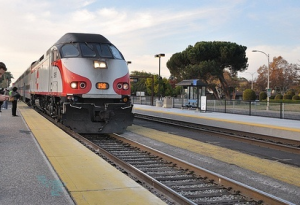
As the commuter rail backbone of Silicon Valley, Caltrain transports some of the most wired passengers in the world. They board each day with laptops, iPads and Blackberries to ride trains that don’t offer Wi-Fi service.
Some of these passengers have grown tired of waiting for Caltrain to catch up with regional rail agencies that recently installed Wi-Fi and saw increased ridership.
The Santa Clara Valley Transportation Authority (VTA) has offered free 4G Wi-Fi on its entire light-rail fleet since July and reports an uptick in passengers. The Capitol Corridor Intercity Rail Service, running trains between Oakland and Sacramento, has invested $3.75 million to install wireless systems on all trains by the end of this year.
The Intercity agency projects the new service would lead to a 2 to 3 percent gain in passengers, spokeswoman Luna Salaver said. “In the Bay Area, you have a very technologically wired customer,” she said. “The days when people were content to stare out of a train window are over.”
Caltrain could reap a similar benefit, Wi-Fi advocates say.
“Having Wi-Fi on the train would give Caltrain an even greater advantage over driving. You can’t work on your laptop while you’re on the road,” said Adina Levin, co-founder of a grassroots coalition known as Friends of Caltrain. The coalition, which lists its members as environmentalists, neighborhood groups and transit riders, issued an “action alert” on its website Oct. 12, encouraging people to lobby Caltrain for Wi-Fi by filling out an online form.
Organizations representing Silicon Valley businesses also would like to see Wi-Fi fast-tracked. “Many people work on the train. They see it as a time they can be productive, and not having Wi-Fi hampers their productivity,” said Jessica Zenk, transportation policy director for Silicon Valley Leadership Group, whose member companies employ more than 250,000 people in the valley.
At a public meeting Oct. 4, Mark Simon, the agency’s public affairs executive, said Caltrain is considering the feasibility of Wi-Fi, after an unsuccessful pilot program in 2006. The pilot, according to Simon, was “very expensive” and the first of its kind in the nation; it stalled because “there was not available funding to move forward,” said Christine Dunn, a Caltrain spokeswoman.
“We’re not going to drop the subject, but don’t want to do it unless the service is reliable,” Simon said during the meeting at Palo Alto City Hall.
Simon’s remarks preceded good news for the agency. On Oct. 6, Caltrain announced that total ridership for August had reached a record high, up 13 percent from the same month in 2010, for a total of about 1.25 million.
Fare box revenues were reported up 15 percent. The jump in ridership came as the base far increased 25 cents effective July 1.
The future of Wi-Fi appears to hinge entirely on money. After declaring a financial emergency in January, Caltrain recently stabilized its budget for the 2013 fiscal year without slashing train schedules, Dunn said. But the transportation service still lacks a dedicated funding source such as a parcel or sales tax.
“There will likely be a ballot measure to help support Caltrain in 2012,” Levin predicted. “Anything that Caltrain can do to increase ridership and make riders happier will increase the public support needed to secure stable funding.”
Dunn said, “We think Wi-Fi is a great idea, but right now our efforts are concentrated on keeping the service that we have.”
Wi-Fi advocates argue that installing wireless services could bring political and economic benefits. If a transportation agency is savvy with wireless implementation, it can save money in other cost areas, ultimately paying for the service, according to Jim Baker, CEO of Xentrans, a consulting service for in-vehicle wireless system design.
“A train’s wireless system can be used for things like CCTV, GPS, vehicle tracking, passenger information systems, and monitoring onboard systems like braking and air conditioning to identify problems before they arrive,” said Baker, who managed the Wi-Fi deployment for VTA. He also is overseeing the installation of Wi-Fi on the Amtrak fleet in California.
“The ball is rolling,” Baker said. “If Amtrak and VTA have deployed Wi-Fi, then it is only a matter of time before the other agencies in the Bay Area will do the same.”
Caltrain officials agree the question is not if, but when.
“Our customers want it and this has come through loud and clear,” said Arthur Lloyd, Caltrain’s longest-tenured board member.
